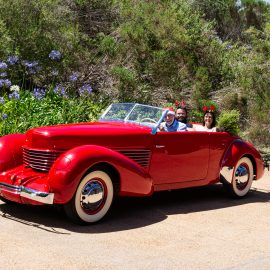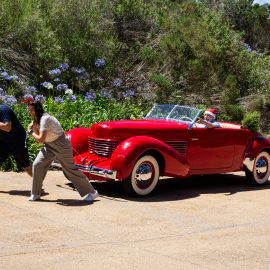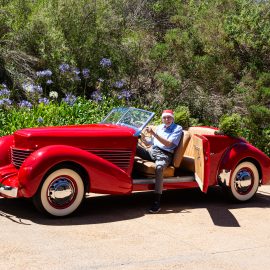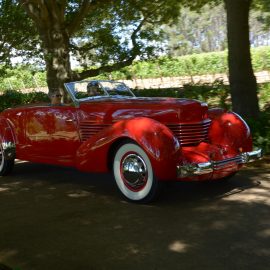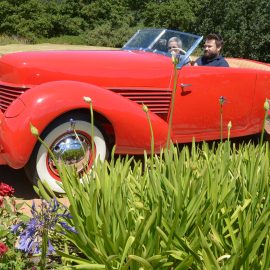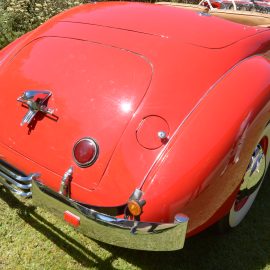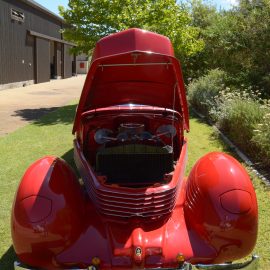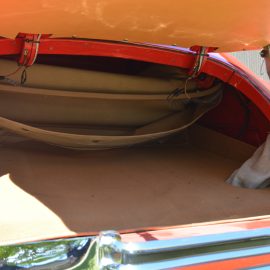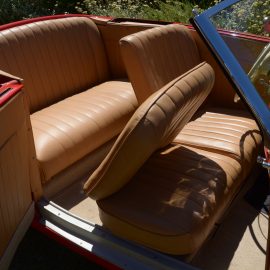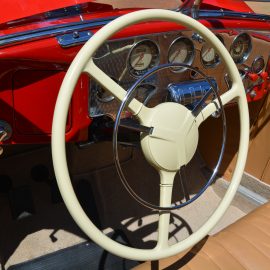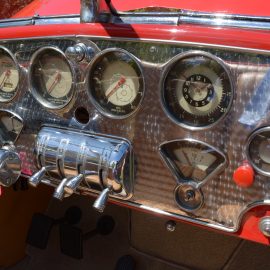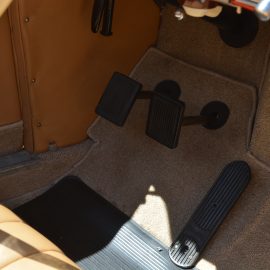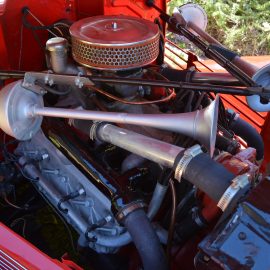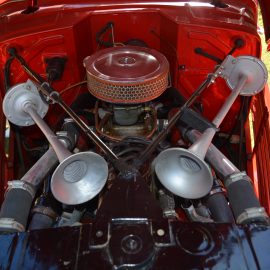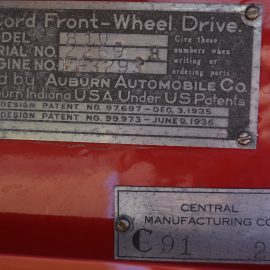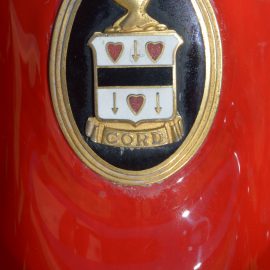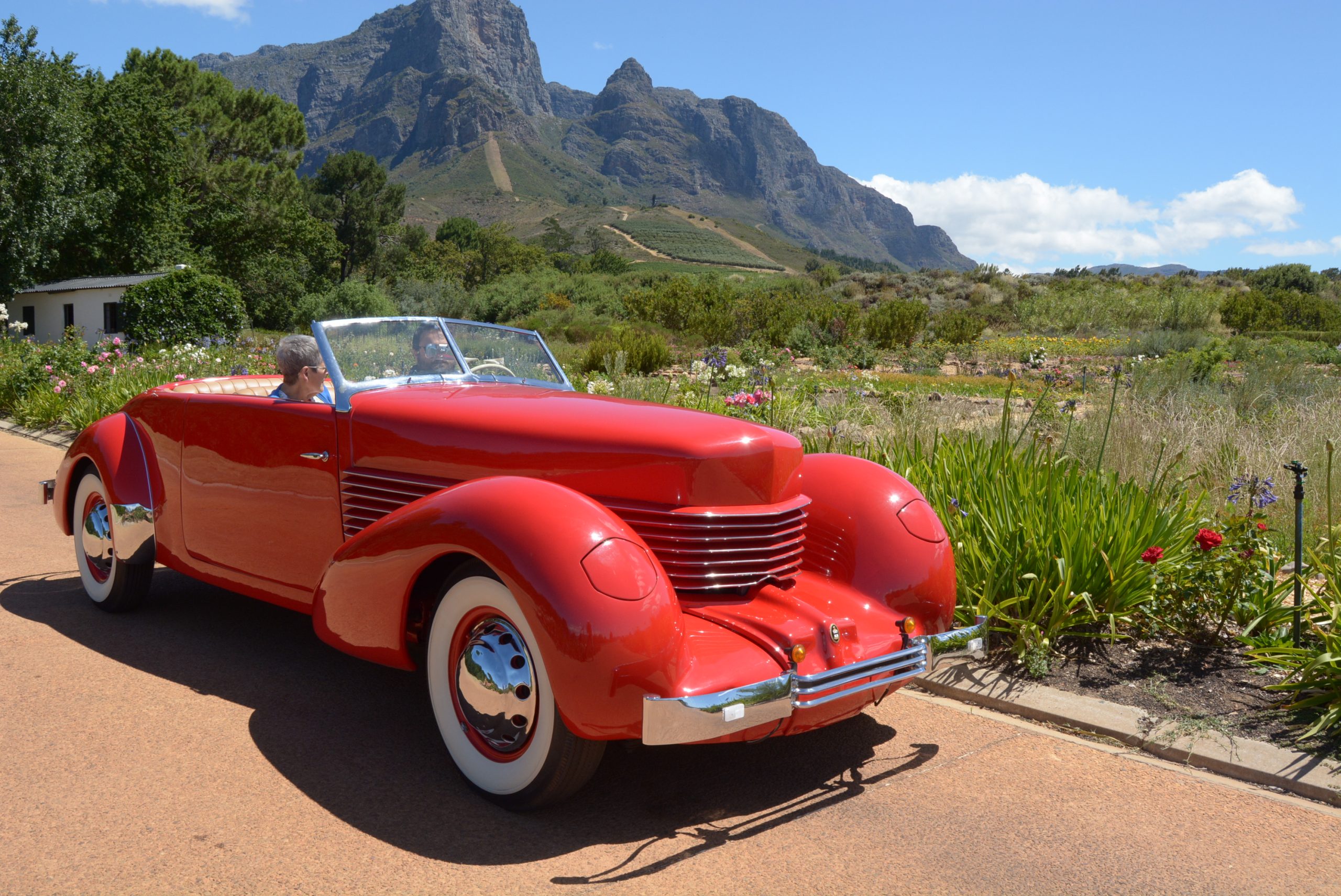
18 Dec Collection In Action: The Cord 810
The sun’s shining, it’s nearly Christmas, so what better way for Santa Mike to enter the Festive Season than aboard his sleigh named Cord and his faithful reindeers Sian and JP…
The Cord 810 (and, later, Cord 812) was a luxury automobile produced by the Cord Automobile division of the Auburn Automobile Company in 1936 and 1937. The styling of the Cord 810 – originally conceived as a ‘baby Duesenberg’ – was the work of Duesenberg Chief Body Designer Gordon M Buehrig and his team of stylists. It was the first American-designed and built front-wheel drive car with independent front suspension.
While its FWD layout was an American first, it had an archaic tube rear axle with semi-elliptic rear springs. Power came from an aluminium 289 ci (4 736 cc) side-valve Lycoming V8, which, with a single Stromberg carburettor, delivered 125 hp (93 kW) at 3 500 r/min. Lycoming was part of the Auburn-Cord-Duesenberg organistaion. The Bendix electro-vacuum pre-selector four-speed transmission extended in front of the engine, like on a Traction Avant Citroën. This set-up eliminated having a transmission tunnel. Gemmer unassisted steering – with a huge 6,2-metre turning radius – was fitted, along with hydraulic four-wheel drum brakes.
These Cords were also the first production cars to feature hidden/pop-up headlights, which were modified Stinson landing lights that disappeared into the fenders via dashboard hand cranks. Additionally, the radical new styling of its nose completely replaced the traditional radiator grille, in favour of horizontal louvres that curved all around the sides of the nose, earning the car’s styling the nickname of ‘coffin nose’. Accentuating its sleek, low-slung look, it also dispensed with running boards. Reportedly conceived as a Duesenberg and nearly devoid of chrome, the 810 had hidden door hinges and a rear-hinged bonnet rather than the side-opening type more usual at the time. It also featured a concealed lockable fuel filler door and variable-speed windshield wipers. Its engine-turned instrument panel housed complete instrumentation including a tachometer.
The car caused a sensation at its debut at the New York Auto Show in November 1935. The crowds were so dense attendees stood on the bumpers of nearby cars to get a look. Cord had rushed to build the 100 cars – they were hand built in just four months – needed to qualify for the show, but the transmission was not ready. Even so, Cord took many orders there, promising Christmas delivery. Expected production of 1 000 cars per month failed, however, to materialise as the transmission proved more troublesome than expected. The first production cars were not ready to deliver until February, and did not reach New York City until April 1936. In all, Cord managed to sell only 1 174 of the 810 in its first model year, as the result of mechanical troubles. In 1936, the 810 was offered in four body styles: the entry-level sedan at $1995, the Beverly sedan ($2095), Sportsman ($2145), and Phaeton ($2195).
Such is Cord’s confusing use of body style terminology, I still cannot say whether FMM’s example is a 1936 810 Sportsman or Phaeton – I favour Sportsman, but that is said to have only two seats whereas this car is a four-seater, which is to Phaeton spec. You choose! Back to the car…
After a bit of photo fun for a feature heading shot, Wendy, JP and I went for a festive ride around L’Ormarins. JP had recently given the car a tune-up and it certainly lived up to expectations. It looks majestic – the gleaming red paintwork is almost eye-blistering – and once on the move it sounds absolutely glorious, the bark from the exhaust announcing performance with panache. In reality, top speed quotes claim figures between 150 and 160 km/h and a 0-96 km/h of around 20 seconds, which is hardly blistering pace by modern standards. But bowling along in a car that is simply drop-dead gorgeous far outweighs any speedo and stopwatch data.
To drive the 810 is pure Hollywood, right here in Franschhoek. No ocean boulevard, but magnificent mountains instead as a backdrop. The narrow windscreen does just about enough to deflect air over front passenger heads. Cruise along taking in the sights, smells and sounds of the estate, then ‘put foot’ and the atmosphere crackles with that V8 beat that never fails to stir the senses. The experience really is something special.
The design of the Cord 810/812 remains one of the most distinctive of the 20th Century, and is recognised by the Museum of Modern Art as one of the 10 finest examples of industrial styling, apparently the only automobile to be so honoured. The ‘Classic Cord’ Hot Wheels toy car of the 1960s, a convertible coupé, is one of the most valuable.
Although most new owners loved their sleek fast cars, the dealer base shrank rapidly. Early reliability problems, including slipping out of gear and vapour lock, cooled initial enthusiasm. Unsold left-over and in-process 1936 810 models were re-numbered and sold as 1937 812 models. Total 810/812 production was 2 972 cars, including 205 convertible cabriolets, before the production ended in 1937.
Given that there were not many made, not only is FMM’s superb example a relative rarity, but of those cars that have survived, many have been mechanically changed to eliminate the problematic drivetrain, so the museum’s car is even more of a rarity. Look out for news on upcoming display plans for the car.




